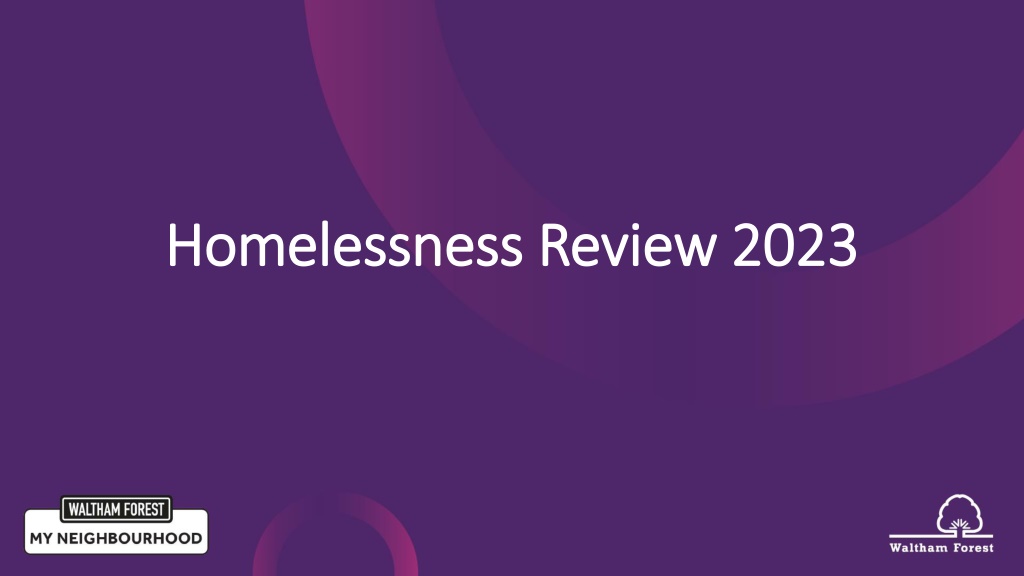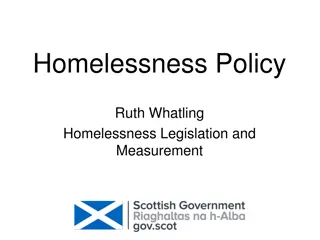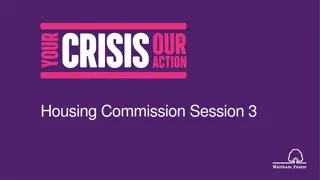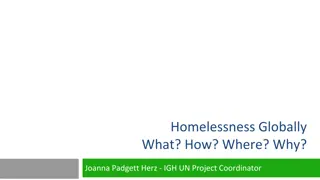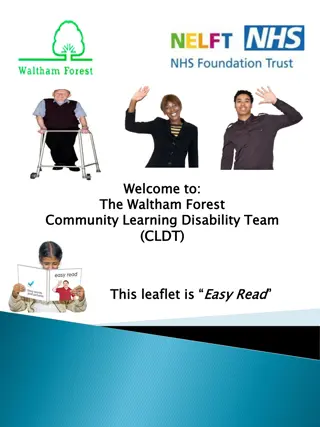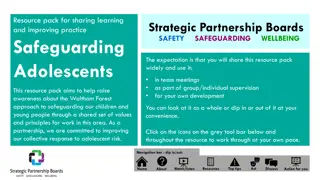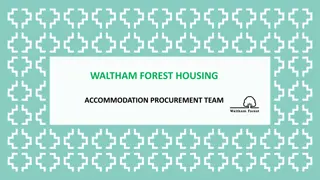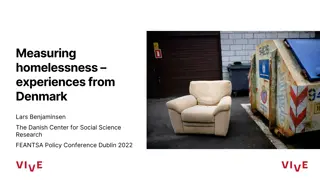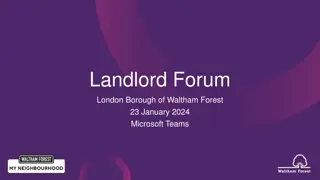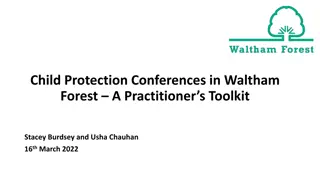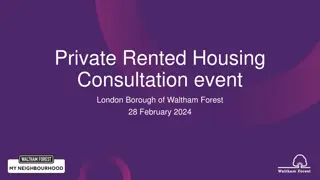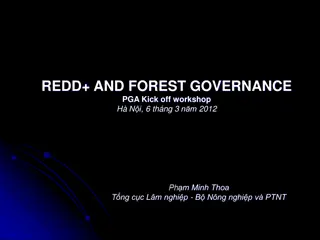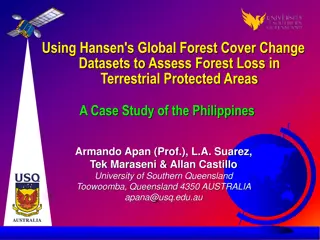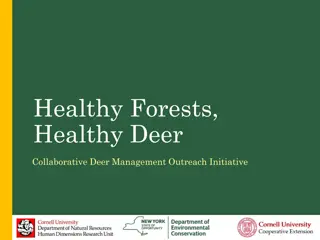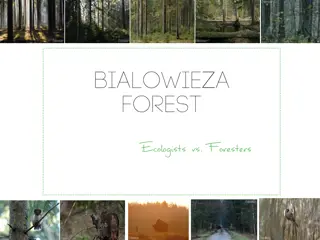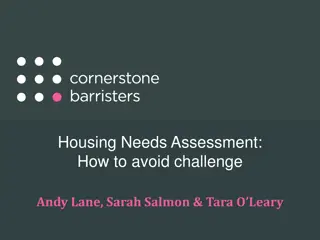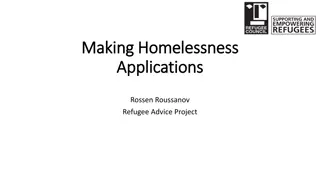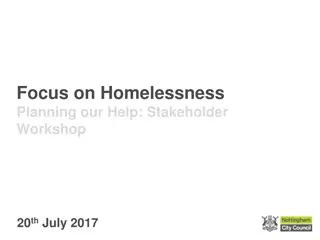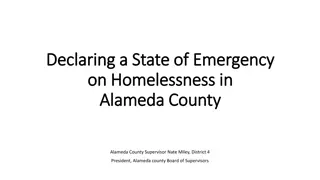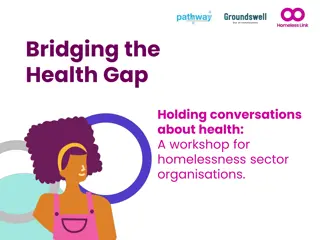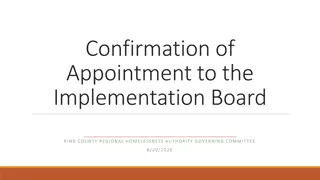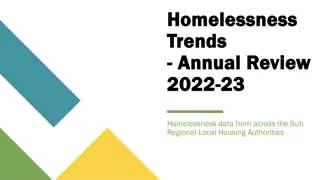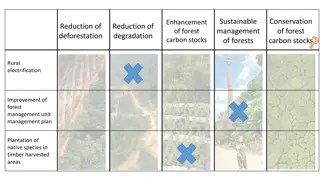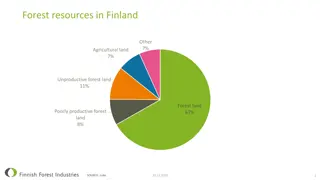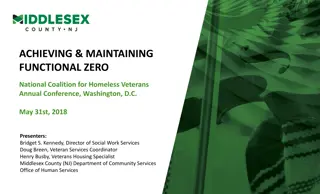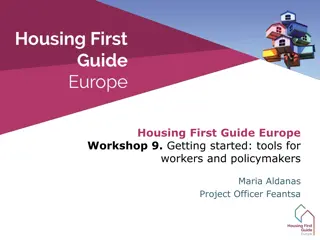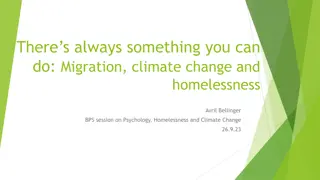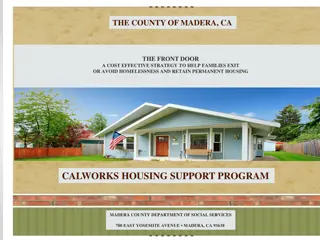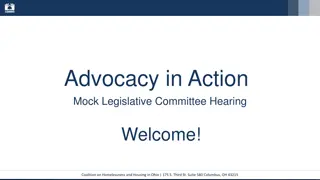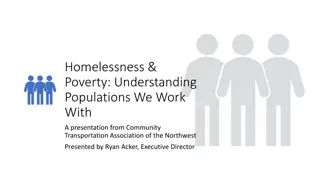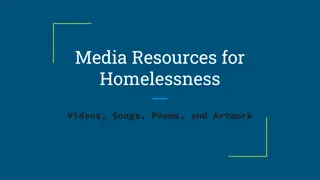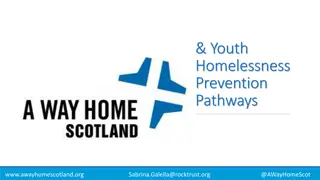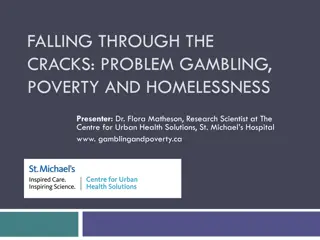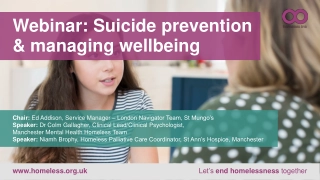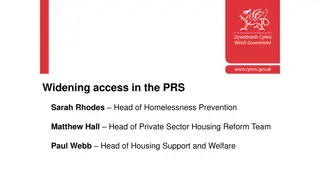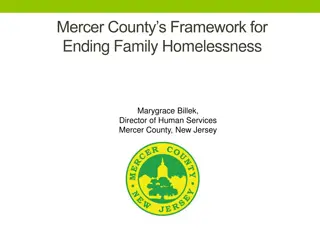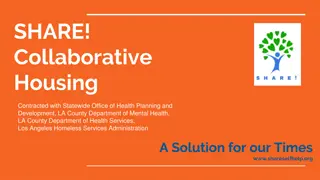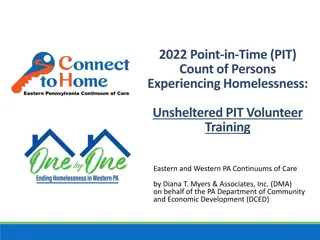Waltham Forest Homelessness Review 2023: Progress and Strategies
The Waltham Forest Council's ongoing efforts to address homelessness are outlined in the review, highlighting key achievements, changes since the 2018 review, and strategies moving forward. The focus is on supporting growth, preventing homelessness, providing suitable accommodations, and ensuring the well-being of vulnerable groups within the community.
Uploaded on Sep 26, 2024 | 0 Views
Download Presentation

Please find below an Image/Link to download the presentation.
The content on the website is provided AS IS for your information and personal use only. It may not be sold, licensed, or shared on other websites without obtaining consent from the author. Download presentation by click this link. If you encounter any issues during the download, it is possible that the publisher has removed the file from their server.
E N D
Presentation Transcript
Homelessness Review 2023 Homelessness Review 2023
Contents Slide Introduction 3 Requirement to produce a homelessness review and strategy 4 Aims of the Housing Futures Strategy 2019-24 5 Changes Since the 2018 Homelessness Review 6 Key achievements since the 2018 Homelessness Review 7 Housing Affordability Home Ownership 8-9 Housing Affordability- Renting in the Private Sector 10-11 Demand for Social Housing 12 Housing Allocations 13 Homelessness Reduction Act (2017) 14 Bridges 15 DAHA 16-19 Homelessness in Waltham Forest 20-23 Rough Sleeping 24-29 Social Housing Supply and Lets 30-31 Temporary Accommodation 32-33 Temporary Accommodation and Resettlement Team (TARSO) 34 Advice Services 35 Supported Accommodation in Waltham Forest 36 Summary 37
Introduction Waltham Forest Council s previous Homelessness Review was completed in 2018 as part of the research for our 2019-2024 strategy, Housing Futures: A Decent Roof for All. This document serves as an update to that review and will contribute towards our revised strategy
Requirement to produce a homelessness review and strategy. The Homelessness Act 2002 includes a requirement that all local authorities must undertake a Homelessness Review and develop and publish a Homelessness Strategy every five years. Local authorities are required to consider the following as part of their Homelessness Review: 1. The current and future level of homelessness in the Borough. 2. The services provided which: a) Help to prevent homelessness b)Help to find accommodation c)Provide support for homeless people, including support to prevent them from becoming homeless again. 3. The resources available to the authority, including housing and social services, other public authorities, voluntary organisations and other agencies for providing these services. Our current strategy expires in 2024. However, there is a need to refresh the strategy to respond to the since 2019. These include the Covid-19 pandemic, Cost-of-Living Crisis and Climate emergency.
Aims of the Housing Futures Strategy 2019-24 Supporting growth and aspirations within the borough Meeting our housing delivery target of 18,000 homes over the next ten years Creating great places to live Supporting residents needs and aspirations Contributing to the London Borough of Culture legacy Tackling and preventing homelessness Implementing the Homelessness Reduction Act focus on prevention Providing suitable accommodation where homelessness cannot be prevented reducing the need for temporary accommodation Ensuring support for vulnerable groups Tackling rough sleeping Ensuring Decent, Safe and Healthy Homes Investing in our own stock Improving standards in the private rented sector Supporting residents health and independence Think Family Think Housing Think Review and deliver housing that meets the needs of specific groups including specialist supported housing Meeting the needs of our communities through resident engagement Providing housing options available for those with a local connection including our younger residents New developments meeting the needs of the community Embracing economic growth Working across the Council and beyond to make Waltham Forest a safe place to live
What has changed since previous Homelessness Review in 2018? There have been substantial changes nationally which have impacted homelessness in Waltham Forest since the introduction of the Housing Futures Strategy. The implementation of the Homelessness Reduction Act 2017 from April 2018. The Covid-19 Pandemic in 2020 changed the way we delivered services to residents. The reception at Cedar Wood House closed and staff moved to conducting assessments virtually. In April 2019 Waltham Forest declared a climate emergency and announced an ambitious plan to be carbon neutral by 2030. The Cost-of-Living Crisis increased the need to support our most vulnerable resident. Energy Crisis increase the need to ensure residents homes were well insulated and heat efficient
Key achievements since the 2018 Homelessness Review Implementing the Homelessness Reduction Act focus on prevention In preparation for the HRA the Prevention and Assessment Team moved from an appointment only service to a drop in. Increased a focus on prevention with new staff training and the introduction of the staff procedures manual. The service successfully switched to conducting assessments online during the Covid-19 pandemic. Ensuring support for vulnerable groups In 2022 Housing Solutions and Housing Management and the two TMOs achieved accreditation form the Domestic Abuse Housing Alliance (DAHA). The accreditation required an in-depth review of case management processes, policies, and procedures to ensure responses to domestic abuse represents best practice. This work shows Waltham Forest commitment to community safety and supporting vulnerable people. Providing suitable accommodation where homelessness cannot be prevented reducing the need for temporary accommodation In 2021 the Rehousing Team successfully launched the new Housing Allocation Scheme in 2021. This scheme allows the Council to allocate this scarce resource as fairly and effectively as possible. There has been a substantial fall in the number of households in temporary accommodation This has fallen from 2235 in March 2018 to 878 in March 2023. Tackling rough sleeping Waltham Forest have secured Housing Service has successfully secured over 7m funding from DLUHC and the GLA, to develop a Rough Sleeper pathway within the borough. The service has successfully launched a several intervention including the assessment bed project, Housing First and supported accommodation at Heavitree Court.
Housing Affordability Home Ownership There is a lack of affordable housing across the United Kingdom. The Conservative Party manifesto included a pledge to build 300,000 new homes per year by the mid-2020s London has a shortage of affordable housing. The Mayor of London s London Plan, adopted in March 2021, outlines a target to achieve 52,000 new housing completions per year . The Council recognizes that Waltham Forest continues to be impacted by the housing crisis. There are many unique factors contributing to the lack of affordable housing in the borough. The Census 2021 show that in the ten years between 2011 and 2021 the population of Waltham Forest increased by 7.8%, from around 258,200 in 2011 to around 278,400 . Waltham Forest is now among the top 5% most densely populated English local authority areas. Waltham Forest has also experienced the fastest house price growth in London. Prices increased 118% over ten years from 2011. The Council has appointed the Waltham Forest Affordable Housing Commission, a panel of independent experts, to review the Council s approach and make recommendations on how it can maximise the delivery of genuinely affordable housing in the future.
Average House Price in Waltham Forest 600000 550000 500000 450000 400000 350000 300000 7/1/2018 1/1/2018 3/1/2018 5/1/2018 9/1/2018 1/1/2019 3/1/2019 5/1/2019 7/1/2019 9/1/2019 1/1/2020 3/1/2020 5/1/2020 7/1/2020 9/1/2020 1/1/2021 3/1/2021 5/1/2021 7/1/2021 9/1/2021 1/1/2022 3/1/2022 5/1/2022 7/1/2022 9/1/2022 11/1/2021 11/1/2018 11/1/2019 11/1/2020 11/1/2022 Waltham Forest Average Sale Price London Average Sale Price
Housing Affordability- Renting in the Private Sector The number of people renting private properties in Waltham Forest has increased steadily over the last decade. Census data shows that the percentage of households private renting increased from 25.9% to 27.8% between 2011 and 2021. The rapid increase in property prices in Waltham Forest is fuelling a corresponding increase in private rent levels. Evidence presented to the Affordable Housing Commission shows that there has been a 42% increase in mean rents between 2012 and 2019 The Local Housing Allowance (LHA) rate is the maximum amount of housing benefit a private renter can claim to help them pay their rent. When the LHA was introduced in 2008 the rate was calculated to cover rent for the cheapest 50% of the housing market in a specific area, known as Broad Rental Market Area . In 2011 the LHA rate was reduced to cover only the bottom 30% of the local housing market. In 2013, the link between LHA rates and actual rent increases was broken, resulting in a two-year 1% rise and a four-year freeze from April 2016, during which time actual rents continued to rise rapidly, particularly in London. In April 2020 the Government realigned LHA rates with the 30% percentile. As part of the economic support provided during Covid-19. However, LHA rates have been frozen since this time whilst rents have continued to increase.
Average Monthly Rents Compared to LHA Rates Property Size Average monthly rent Walthamstow Average monthly rent Leyton Monthly Local Housing Allowance (LHA) (Outer East London BRMA) One Bed 1,431 2,102 1047.11 Two Bed 1,811 2,629 1296.45 Three Bed 2,265 3,302 1545.74 Four Bed 3,516 3,714 1795.08 Property Size Average monthly rent Chingford Monthly Local Housing Allowance (Outer North East London BRMA) One Bed 1,393 897.52 Two Bed 1,710 1146.86 Three Bed 2,356 1371.24 Four Bed 3,038 1725.27
Demand for Social Housing In March 2023 there were 6255 households on the housing register. This is a slight reduction from 7961 households in 2018. This change is likely to be because the new allocations policy requires applicants to re- register annually in order remain on the housing register. The chart below illustrates the breakdown of property sizes required. Studio / 1 Bed 2 Bed 3Bed 4+ Bed Under Assessment Total All Sizes Housing Register 2342 1820 1283 248 30 5723 Council Tenant Transfer 109 185 195 35 8 532 Totals 2451 2005 1478 283 38 6255
Housing Allocations Waltham Forest launched a new Housing Allocations Scheme in February 2021. The scheme determines the priority of applicants on the register and the procedure to be followed when it allocates social housing. In accordance with Part 7 of the Housing Act 1996, and the Homeless Reduction Act 2018, reasonable preference is given to certain categories of people who are homeless. Vulnerable groups may also be awarded additional preference on the Housing Register including: Applicants who are homeless or where the Council has accepted a Prevention or Relief. Applicants from supported housing schemes nominated for move-on accommodation Applicants referred under the Channel quota, the Safe and Secure quotas or the MAPPA quota Applicants referred under the Rehabilitation (alcohol and substance misuse quota) Applicants referred under the Veteran s Nomination Scheme Applicants awaiting urgent discharge from hospital Care Leavers
Homelessness Reduction Act (2017) There have been significant changes to statutory framework used to access homelessness since our last homelessness review. The Homelessness Reduction Act (HRA) came into force in April 2018. The Act made significant changes to the Housing Act (1996) and placed a number of new duties upon local authorities. These include: Extending the period a household is threatened with homelessness from 28 days to 56 days, meaning that local authorities have a duty to prevent homelessness from an earlier stage. To develop and agree with applicants a personalised plan of the steps that will be taken to prevent or relieve homelessness. New duties to assess all eligible applicants, not just those who are unintentionally homeless and in priority need. A duty on public authorities to refer service users who may be homeless or threatened with homelessness to the housing authority. Services must be designed to meet the needs of specific groups including care leavers, people discharged from hospital, people released from prison and victims of domestic violence. Responding to the introduction of the HRA was a key priority identified in the Housing Futures housing strategy.
Bridges Single Homeless Peoples Service The Homelessness Reduction Act (HRA) came into force in 2018, which increased the scope of duties owed by Councils. Councils now have a statutory duty to support households who are not in priority need and as a result, have additional duties to Prevention and Relieve Homelessness. Waltham Forest has seen a significant increase in the number of Single adult households, being supported with Prevention and Relief duties. To help us meet this growing need and provide an excellent Customer Service, we have commissioned the Single Homeless Prevention Service (SHPS). SHPS support Single Homeless applicants to sustain their current or secure alternative accommodation. In addition, and with the agreement from the Customer, develop Personalised Housing Plans (PHP s) In 2022/2023, SHPS received 651 referrals and completed 633 PHPs. 394 households were supported to secure accommodation and 238 were able to sustain their accommodation. SHPS success in rehousing single applicants has saved the Council approximately 7533.28 in Temporary Accommodation costs.
Domestic Abuse Housing Accreditation (DAHA) In November 2020, the housing service applied for the Domestic Abuse Housing Alliance (DAHA) Accreditation. The DAHA Accreditation, is national partnership between Peabody, Gentoo and the charity Standing Together Against Domestic Violence. Online training sessions were delivered to all staff across the Housing Services, as well as to repairs and maintenance contractors. Gaining the DAHA accreditation was one of the top priorities for Housing in 2022. The Domestic Abuse Act, which was signed into law in April 2021 places a duty on local authorities in England to provide support to victims of domestic abuse and their children. It makes provision that all eligible homeless victims of domestic abuse automatically have priority need homelessness assistance. Accreditation involved an in-depth review of case management processes, policies, and procedures to ensure our responses to domestic abuse represent best practice. Accreditation achieved in February 2022 on behalf of Housing Solutions Management and the two Tenant Management Organisations Friday Hill and Sansom and Acacia. was and Housing status for
A year in action as an accredited borough Success actualised: Reasons for our successful response to DA: Positive change in organisational culture Solace Women s Aid Housing IDVA Early intervention increased Monthly Case Audits Good levels of Domestic Abuse knowledge amongst staff Multi Agency Collaboration Open communication Case management has improved Holistic reviews Staff are equipped and empowered Domestic Abuse Perpetrator Panels Surrounding risks mitigated Successful tenancy transfers Zero Tolerance towards Perpetrators Enforcement powers utilised Resources Transparency between Council and survivors Co-creation with DA Leads
Housings commitment to protecting survivors of Domestic Abuse Collaboration and joint working with community safety, VAWG service team, MARAC, MASH. Focused Communications and Engagement Digital visibility Domestic Abuse Service Strategy 9 R s Review Monthly Case reviews Reduction Reduction of DA cases. Reduction of second time approaches. Replenish To replenish the lives of survivors by giving them lost time back Refuge Move on support. Improving our reputation and response. (keeping more survivors in London) Reception Families and Homes Hub Recruitment and Retention Ensuring that we are supported in service. Anti-Racial Practice Focused on anti racial practices (SHARP) Representation minority communities and needs are addressed. Referrals Ensuring correct referrals are made to support services and agencies.
Services to support survivors of domestic abuse The Council works closely with a range of partners to support survivors of domestic abuse. These include: Ashiana Network receives funding from Waltham Forest Council towards its service which delivers specialist refuge, advice, support and counselling services for black, and minority ethnic women and girls affected by domestic violence, sexual violence, forced marriage, honour-based violence, female genital mutilation and women who have no recourse to public funds. Refuge is a national organisation which supports women, children & men with a range of services, including refuges, independent advocacy, community outreach & culturally specific services; it has a contract with Waltham Forest for the provision of refuge units. Solace Women's Aid runs the Independent Domestic Violence Advocacy Service in Waltham Forest providing support to high-risk victims who have suffered from emotional, verbal, physical, sexual or financial abuse as well as coercive control.
Homelessness in Waltham Forest Demand for homelessness services continues to rise in Waltham Forest. In 2021/22 Waltham Forest received 1767 homelessness approaches. This is a substantial increase from the 1220 approaches in 2017/18. This increase represents not only continued pressure on the housing service but also the move to a more preventative approach following the introduction of the Homelessness Reduction Act (2017). The service has successfully implemented the Duty to Refer and received 238 referrals from public bodies under the duty to refer. The table below shows the demand for homelessness services Initial Approach Prevention Duty Owed Relief Duty Owed Main Duty Owed 2018-19 1579 947 587 187 2019-20 1689 944 738 305 2020-21 1949 1007 933 431 2021-22 1767 788 969 538 Department for Levelling Up, Housing and Communities Statutory Homelessness Live Tables
Homelessness Acceptances: Diversity Ethnicity of main applicant owed prevention or relief duty 2021-22 According to the 2021 Census the population in Waltham Forest is predominantly white (52.8%) and this group is under represented accounting for only 32% of households owed a prevention or relief duty. 15% of Waltham Forest residents are from black minority ethnic background, this group is over represented accounting for 36% of households owed a prevention or relief duty. 6% 8% 32% 18% 36% White Black / African / Caribbean / Black British Asian / Asian British Mixed / Multiple Ethnic Groups Other
Homelessness Acceptances: Priority Need 65% of cases where homelessness duty was accepted in 2021-22 were due to children being a part of the household. However there has been a notable drop from 2018 when this accounted for 76% of acceptances. Households owed a main duty by priority need -2021 /22 4%2% 10% 12% 1% This could be due to demographic changes in the borough as the Census 2021 shows that Waltham Forest saw England's largest percentage-point rise in the proportion of households including a couple but no children which increased from 11.4% in 2011 to 14.8% in 2021. 6% 65% Household includes dependent children Household includes a pregnant woman Household member vulnerable as a result of old age Household member vulnerable as a result of physical disability / ill health Household member vulnerable as a result of mental health Household member vulnerable as a result of domestic abuse Other
Reason for homelessness Households owed a relief duty by reason for loss, or threat of loss, of last settled home 2021-22 3% 11% The leading cause of homelessness for households owed a relief duty in 2021-22 was Family or Friends no longer willing or able to accommodate . This accounted for 30% of cases owed a relief duty. 23% 2% 4% 31% 1%2% The previous homelessness review found the loss of an AST to be the leading course of homelessness accounting for 38% household owed a duty under Part VII of the Housing Act 1996. Although these figures are not directly comparable this is a change is likely to be linked to a wider issue of the housing and affordability crisis across London and in particular the increase in young people remaining at home longer. 2% 18% End of assured shorthold tenancy End of non-AST private rented tenancy Family or friends no longer willing or able to accommodate Non-violent relationship breakdown with partner Domestic abuse Other violence or harrassment End of social rented tenancy Evicted from supported housing Left institution with no accommodation available Leaving accommodation provided by Home Office as asylum support Other/not known 3%
Rough Sleeping In 2018 the Government published the Rough Sleeping Strategy. The strategy sets out the Government s target of halving rough sleeping by 2022 eradicating all street homelessness by 2027. It emphasises three aspects of its approach: Prevention Intervention Recovery Waltham Forest committed to tackling rough sleeping across the borough in the Housing Futures Strategy. Since 2018, the Housing Service has successfully secured over 7m funding from the Department of Levelling Up, Housing & Communities (DLUHC) and the Greater London Authority (GLA), to develop a Rough Sleeper pathway within the borough. This funding has been used to build a new rough sleepers team and funding accommodation and interventions to support rough sleepers across the borough.
Rough Sleeper Team Funding Rough Sleeper Accommodation Programme funded by GLA Rough Sleeper Initiative funded by DLUHC Interventions funded by the NHS and Public Health Pam-London and Sub-Regional 10 Housing First Properties Housing First Support Officer 23 units of self-contained accommodation at Heavitree Court 24hr support provision for Heavitree Court CGL Street Outreach Team YMCA Assessment Bed Project Rough Sleepers Team Severe Weather Provision (SWEP) Partial funding of Forest Churches Emergency Night Shelter. (FCENS) Homeless Health Project Rough Sleepers Mental Health Project Rough Sleepers Drug and Alcohol Team Hospital Discharge Team Rapid Response Outreach Team funded by GLA Pan-London overflow SWEP provision funded by GLA CHAIN database funded by GLA No Second Night Out funded by GLA RAMFEL sub-regional immigration service funded by London Councils
Rough Sleepers Team ROUGH SLEEPING COORDINATOR this post was established in September 2018 to lead the Council s response to the problem of rough sleeping and to act as a single point of contact for all rough sleeping services in the borough. 4 x SUPPORT OFFICERS providing person-centred, trauma-informed support to rough sleepers who are placed in temporary accommodation. Working in partnership with external agencies, including CGL, NELFT, DWP, RAMFEL etc to address issues around benefits, health, immigration etc. Preparing rough sleepers to live independently and move on to longer settled accommodation. PATHWAY OFFICER assessing needs and providing advice and support to rough sleepers and those at high risk of rough sleeping, ensuring they can access suitable housing solutions. The pathway officer works closely with the outreach team to engage rough sleepers in the community. PREVENTION OFFICER working alongside partner agencies, hostels, single homeless services, and internal departments to highlight people at risk of losing their accommodation and becoming street homeless. Using preventative measures to ensure that people do not lose their accommodation and come to the attention of our services before they reach the streets. 2 x HOUSING FIRST OFFICERS providing personalised support to rough sleepers, those at risk of street homelessness, clients with multiple, high and complex needs accepted for a Housing First service. The Housing First support worker provides a focus on supporting clients in preparing for rehousing, setting up a home and sustaining a tenancy. EMPLOYMENT ADVISOR Offering a bespoke employment service to people who have previously been rough sleeping to build up their confident, work towards removing barriers into the workforce. Securing voluntary opportunities within the community, forging sustainable relationships with local businesses to increase work opportunities for rough sleepers.
Everyone In Covid 19 In March 2020, the government launched its Everyone In initiative to get all rough sleepers off the street. All rough sleepers in Waltham Forest who engaged with services, including those in our Night Shelters, were moved into a commercial hotel; over 90 people were accommodated during this period When the government initiative ended in June 2020 our accommodated rough sleepers were enabled to move from the hotel to other forms of more settled accommodation, including the private sector, supported accommodation and Housing First. The success of this unprecedented intervention enabled us to engage with some of the most vulnerable people in our borough who may not otherwise have engaged with services. The ongoing challenge is to continue to provide appropriate support and accommodation for this group.
Combined Homelessness and Information Network (CHAIN) CHAIN is a multi-agency database recording information about rough sleepers and the wider street population in London. CHAIN is commissioned and funded by the Greater London Authority (GLA) and managed by St Mungo s. CHAIN is the UK s most detailed and comprehensive source of information about rough sleepers. According to the Chain Outer London 2021/22 Annual Report there were 153 rough sleepers in Waltham Forest. 2018-19 2019-20 2020-21 2021-22 Number of people seen sleeping rough. 137 133 261 153
Rough Sleeping Snapshot Every year local authorities report the number of people rough sleeping in heir area on a typical night . This is a single date chosen by the local authority between 1 October and 30 November. Since 2010, the figures used for national statistics have used the following definition of rough sleeping: People sleeping, about to bed down (sitting on/in or standing next to their bedding) or actually bedded down in the open air (such as, on the streets, in tents, doorways, parks, bus shelters or encampments). People in buildings or other places not designed for habitation (such as stairwells, barns, sheds, car parks, cars, derelict boats, stations, or bashes ). The definition does not include people in hostels, shelters, sofa surfers, people in campsites or travellers sites. 2018 2019 2020 2021 2022 Number of people recorded in LBWF 22 18 18 5 27
Social Housing supply The 2021 Census shows that the rate of social renting in Waltham Forest fell from 22.1% to 21.5% over the last 10 years. There are over 15,000 socially rented housing associations and registered provider properties in Waltham Forest There are more than 30 Housing Associations in Waltham Forest. The three largest Housing Associations are London & Quadrant, Peabody Housing Trust and Clarion Housing Group In 2019 Waltham Forest launched the Housing Compact which sets out how we will work in partnership with housing associations The Right to Buy scheme allows eligible council and housing association tenants in England to buy their home at a reduced price. In London, the maximum discount is 127,900. In Waltham Forest 66 properties were purchased through the Right to Buy scheme in 2022-23. Property Size Bedsit One Bed Two Bed Three Bed Four+ Bed Total No. Sold 4 14 27 19 2 66
Social Housing Lets In 2022-23 the total number of lettings of social housing in Waltham Forest made to applicants on our Housing Register, including homeless households, was 552. This included 393 local authority homes and 159 housing association homes. Studio One Bed Two Bed Three Bed Four Bed Not Classified Total LBWF 20 169 100 93 5 6 393 Housing Association 1 68 53 35 1 1 159
Temporary Accommodation Allocations The Housing Futures Strategy include the Council s commitment to Providing suitable accommodation where homelessness cannot be prevented reducing the need for temporary accommodation In April 2021 Waltham Forest published an updated Temporary Accommodation Allocation Policy. The policy sets out the Council s policy for the prioritisation of homeless households for temporary accommodation according to its location. The policy breaks down temporary accommodation into three categories: Zone A located in the London Borough of Waltham Forest (LBWF) Zone B located in Greater London and neighbouring districts in Essex, Hertfordshire, Kent, Surrey, Berkshire and Buckinghamshire Zone C located outside of Zones A and B The Council is committed to providing temporary accommodation in Waltham Forest (Zone A) whenever this is reasonably practical. When it is not possible to place a household in borough an assessment will be completed, in line with the policy. The assessment considers the needs of all household members including employment, education and medical issues.
Temporary Accommodation In March 2023 there were 878 households in temporary accommodation provided by Waltham Forest. The majority of households, 436, were housed in borough (Zone A). 388 households were placed in other London boroughs and 54 families were accommodated outside of London. Type of Temporary Accommodation Number of Households Nightly B&B 71 Nightly Self-Contained 154 PSL 485 Hostel 114 Regen Unit 39 HALS 15 Total 878
Private Rented Sector Offers Since the introduction of The Localism Act (2011) local authorities have been able to discharge their homelessness duty by arranging a suitable offer of accommodation in the private rented sector. Waltham Forest has several schemes to assist households to find suitable accommodation in the private rented sector. The self-help scheme assists applicants by providing the first month's rent, deposit and up to 500 toward relocation costs. The Temporary Accommodation Reduction Project procure PRS accommodation which can be used to discharge the Council s homelessness duty to household owed a main homelessness duty or households owed a relief duty who are in priority need. The team procured 54 in 2022/23 Capital Letters is a partnership between 18 London boroughs. Capital Letters procures private PRS in London. Last year 25 properties were procured for Waltham Forest. More Homes is a partnership between Mears and Waltham Forest purchase and refurbishes PRS properties across London, Hertfordshire and Essex. Under the terms of the scheme after 40 years these properties will belong to Waltham Forest Council. Local Space is an innovative charitable housing association with properties in nine local authority areas across London and Essex. Local Space utilises Right to Buy receipts to purchase PRS properties and then lets and manages properties.
Temporary Accommodation and Resettlement Team (TARSO) The TARSO Team support vulnerable residents living in temporary accommodation both in and outside the borough. The team work to support residents to settle into their new home. The team s activities cover five main areas: 1. Welfare benefit and Income identify, signpost assist where necessary 2. Education and Employment anyone in household who could work. Signpost to employment team or maximus. 3. Financial Health - cost of living advise specific support (support funds, water funds, fuel poverty, debt and budgeting advice.) 4. Tenancy retainment / resettlement - advising housing options/ how to find accommodation / bidding 5. health and wellbeing NHS 5 steps to wellbeing -advice on specific need.
Advice Services The Council works closely with a range of partners to provide advice and support to residents. Cambridge House s Safer Renting Team has been contracted by the Council to provide early targeted outreach advice and advocacy to private tenants. Where appropriate, the team can refer tenants to other specialist services, including legal aid or pro bono solicitors. They work closely with the property licensing team and deliver training and support to Council officers working in the field of homelessness. Waltham Forest Council has a contract with Citizens Advice Waltham Forest to provide financial advice and debt counselling to Council tenants, temporary accommodation residents and homeless applicants to enable them to keep their homes. Citizens Advice also delivers money management workshops for our customers and training for Council staff.
Supported Accommodation in Waltham Forest Branches is a 27-bedroom hostel for homeless people in Waltham Forest which receives funding from Waltham Forest Council, It is operated by WFCNS, a registered charity providing support for rehousing, as well tackling underlying problems and providing access to services for education and training towards employment. Lea Bridge House is a 229-room hostel that provides accommodation for homeless single people aged 25 and above with low support needs. People are referred to Lea Bridge via the local authority or homeless charities. The YMCA in Waltham Forest is a 188-room hostel that provides accommodation to single people aged 18 and above with housing and support needs. The YMCA Young Persons Project has 33 rooms and supports vulnerable homeless young people, aged between 16 and 21.
Summary This review suggests that Waltham Forest continues to suffer from a lack of affordable housing. House prices have more than doubled since 2011. This is the most rapid rise in house prices in London. Private Sector Rents in the borough have also increased. The affordable housing commission found a 42% increase in mean rents between 2012 and 2019. As the borough has become more unaffordable there has been an increased demand for homelessness services. In 2022-23 1767 households approached the Council for homelessness assistance and the Council accepted a main homelessness duty to 538 households. Despite the increased demand for homelessness services the use of temporary accommodation has reduced dramatically over the last 5 years. In March 2018 there were 2235 households in temporary accommodation by March 2023 this had reduced to 878. The available data from CHAIN and the snapshot shows there is a growing need for services to support rough sleepers in the borough.
